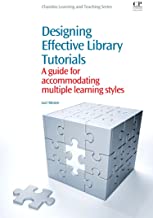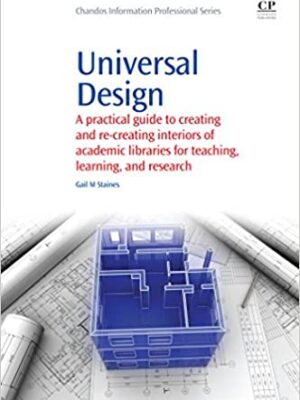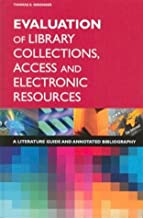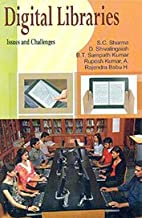Designing Effective Library Tutorials: A Guide for Accommodating Multiple Learning Styles
Original price was: ₹6,948.00.₹5,558.40Current price is: ₹5,558.40.
ISBN: 9781843346883
Author/Editor: Lori S. Mestre
Publisher: Chandos Publishing
Year: 2012
2 in stock (can be backordered)
Description
Learning styles are highly relevant for students in the online environment. Designing Effective Library Tutorials provides examples of, and steps for, how to create tutorials that match learning styles, based on usability studies of students from various cultural groups and styles of learning. The book presents studies, practical suggestions, and examples to assist librarians and faculty as they develop online programs for students from diverse learning styles. Research on learning style preferences in the online environment emphasizes the need to provide a variety of methods that include text, aural, visual, and kinesthetic examples. Geared for the practitioner working in online learning, the book summarizes current literature, and presents best practices for designing effective online tools for diverse learners, including suggestions for assessment of learning objects.
This title is structured into twelve chapters, covering: The learning style debate: do we need to match up learning styles with presentation styles? Overview of learning style theories and learning style results from various studies; The intersection of culture and learning styles; The need for learning object development; Current practice: categories and features of library tutorials; Effective design of learning objects; Pedagogical considerations for tutorials; Interactivity options for tutorials; Assessment of learning objects; The value and process of usability studies; Marketing learning objects for broad visibility; and a section on resources.
Provides results from usability studies conducted with students that assess learning style and the resulting effectiveness of tutorials based on their preferred style
Compares approaches and software used by librarians and educators to create tutorials, along with examples of pitfalls and benefits of each for various learning styles
Incorporates examples of ways to use software while including learning objects to match learning style
Additional information
| Weight | 0.6 kg |
|---|
Product Properties
| Year of Publication | 2012 |
|---|---|
| Table of Contents | List of figures, tables and charts Acknowledgements About the author Introduction: matching online learning and tutorial design with learning styles - the student perspective Chapter 1: The learning styles debate: do we need to match up learning styles with presentation styles? Abstract: Introduction Learning gains? Are learning styles measurable? Criticisms of tailoring instruction based on learning styles Does knowing a student? learning style make teachers more effective? Should we match teaching style to the content being taught? Solutions and compromises regardless of the controversy Conclusion Chapter 2: Overview of learning style theories and learning style results from the Mestre study Abstract: Introduction Learning style models and inventories Discussion Conclusion Chapter 3: The intersection of culture and learning styles Abstract: Introduction Some examples of the relevance of culture and learning styles Global and analytical learners Culturally responsive instruction Suggestions for accommodating various cultural and learning styles Conclusion Chapter 4: The need for learning object development Abstract: Introduction Learning objects, web-based instruction, and tutorials Benefits of learning objects Tutorials for teaching faculty Challenges of creating learning objects Overview of the faculty? or librarian? role in creating tutorials Access to existing tutorials Students?perceptions of learning objects Personalization Conclusion Chapter 5: Current practice: categories and features of library tutorials Abstract: Introduction Web-based tutorials with screenshots Tutorials created with screencasting software Podcasting/vodcasting Mobile applications Videos Montages Conclusion Chapter 6: Effective design of learning objects Abstract: Introduction Involving the stakeholders Designing for quality instruction Developing goals and the design plan The script Navigation and consistency across tutorials Designing for different ability levels Other technical considerations Accessibility Assessment of the learning object Conclusion Chapter 7: Pedagogical considerations for tutorials Abstract: Introduction Meaningful content Modular design Cognitive science applied to instruction design Models for integrating good pedagogy into tutorials Getting help with integrating effective pedagogy in multimedia Conclusion Chapter 8: Interactivity options for tutorials Abstract: Introduction What qualifies as being interactive? Interactivity and active learning Planning for interactivity Interactive activities Developing effective questions Seeking help Multimedia suggestions Pick and choose options Concerns about adding multimedia Learning style considerations A checklist for considering multimedia interaction Conclusion Chapter 9: Assessment of learning objects Abstract: Introduction How is success measured? Methods of assessment Steps for assessment Assessment and maintenance of tutorials Conclusion Chapter 10: The value and process of usability studies Abstract: Introduction Definitions of usability testing Purpose of usability testing Methods Guidelines for usability testing Process for performing usability studies Resources needed for usability testing Iterative testing and analysis Conclusion Chapter 11: Marketing learning objects for broad visibility Abstract: Introduction The message Working with faculty to promote tutorials and websites Social network tools Making resources more visible Suggestions for promoting, linking, and embedding learning objects Other resources Conclusion Chapter 12: Resources Abstract: Learning style inventories Repositories and sites for hosting learning objects and tutorials Organizations and websites devoted to online learning Storyboarding sites Free CGI scripts on the Internet Scripts for usability studies Screen capture tools Screencasting tools, including screencasting help, open source tools, and commercial software General software for creating learning objects PowerPoint/Flash conversion Images (image sites, image capturing and editing tools) Audio Video and software to integrate photos, videos, and audio (video editing and other software) Puzzles, games, and activities Simulation, scenario, and animation tools Mobile applications Testing and assessment tools Eye tracking software and equipment Appendix 1: Survey to librarians: conducted by Lori Mestre, University of Illinois at Urbana-Champaign Appendix 2: Learning style tutorial usability questions/script for ERIC, ORR, interactive tutorials (Group A) Appendix 3: Learning style tutorial usability questions/script for ORR, ERIC, interactive tutorials (Group B) Appendix 4: Guidelines and procedures for creating tutorials in Camtasia Appendix 5: Marketing communication plan Appendix 6: Suggestions for multimedia inclusion |
| Author | Lori S. Mestre |
| ISBN/ISSN | 9781843346883 |
| Binding | Paperback |
| Edition | 1 |
| Publisher | Chandos Publishing |
You must be logged in to post a review.





Reviews
There are no reviews yet.